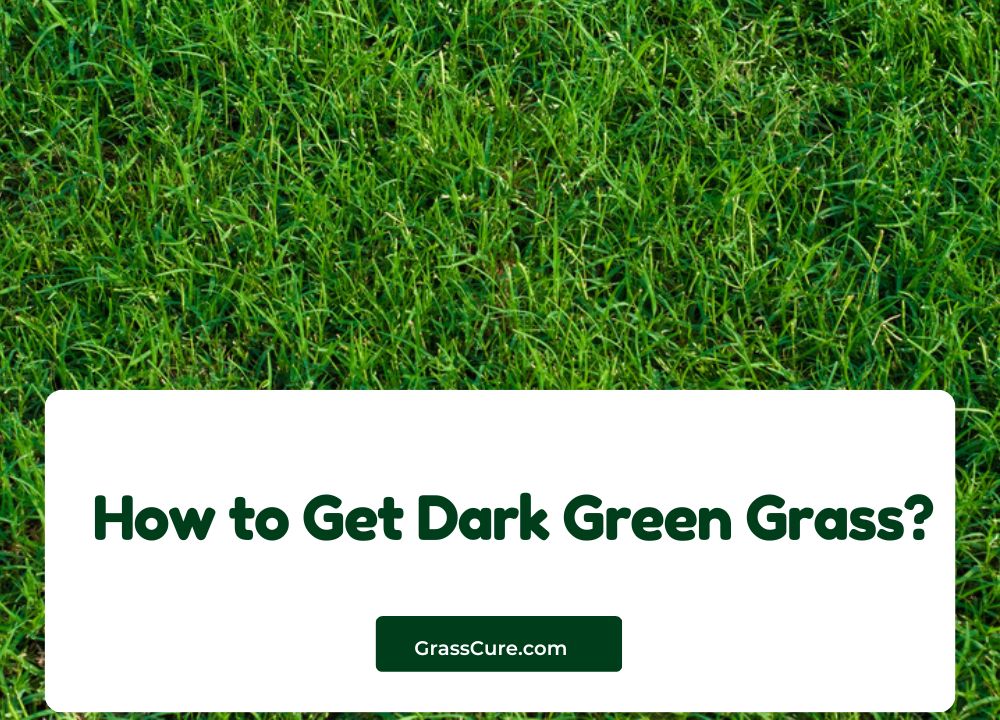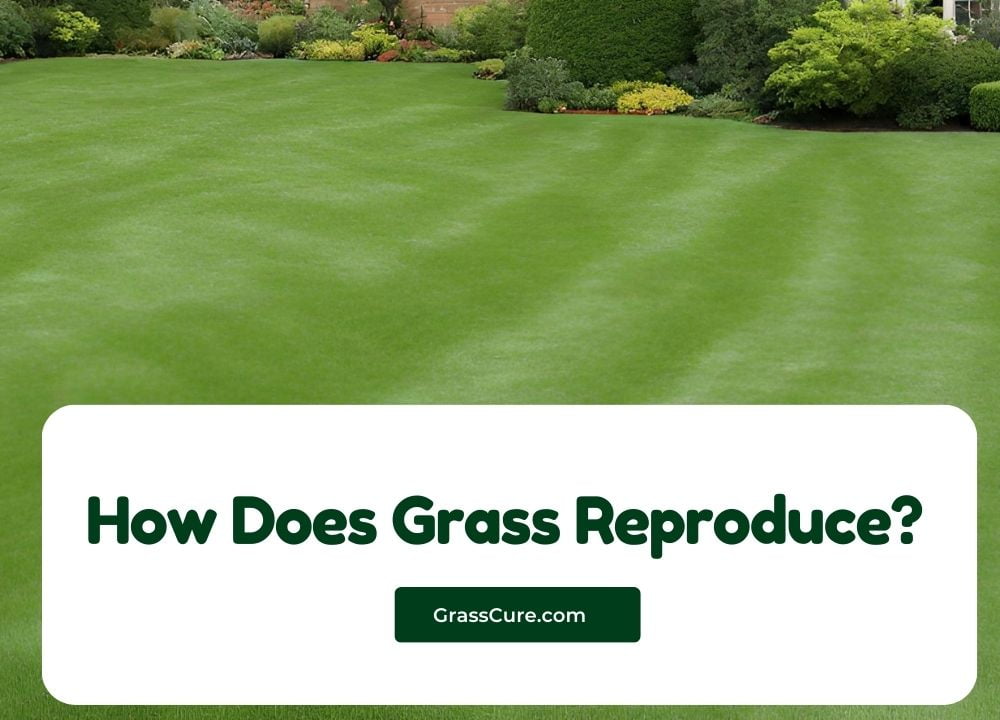Everyone wants to achieve that green-dark, healthier, and beautiful grass. Some claim that their lawn is well mowed, thatched, fertilized, and irrigated, but it must still be dark green. Do I add iron or other supplements or what? This article will help you learn how to get dark green grass.
A dark green lawn looks nice and makes your home’s outdoor area inviting. But making your grass dark green isn’t magic; it’s about properly caring for it. This simple guide will show you the easy steps to make your lawn dark green. Whether you are new to gardening or have done it, we’ll help you make your grass look fantastic. We’ll start by checking how your lawn is doing right now.
Then, we’ll discuss things like cutting the grass, giving it the proper water, and using the correct plant food. Don’t worry; it’s not as complicated as it sounds. We’ll also discuss improving your soil and protecting your lawn yearly. Plus, we’ll explore ways to do all this while being kind to the environment. So, let’s begin our journey to get that beautiful dark green grass everyone will admire.
Why isn’t my grass dark green?
If your grass is not dark green, there could be several reasons behind it. Let’s explore some common factors that might be causing your grass to appear less green than desired:
Lack of Nutrients: Grass needs proper nutrients to grow dark green and healthy. Your grass may thrive if your soil has essential nutrients like nitrogen, phosphorus, and potassium. Consider fertilizing your lawn according to its specific needs, as determined by a soil test.
Improper Mowing: Cutting your grass too short or infrequently can weaken it and result in a less vibrant green color. Ensure you’re mowing at the recommended height for your grass type and maintain a regular mowing schedule.
Inadequate Watering: Grass needs consistent and deep watering to stay green. It can affect its color if you need to water your lawn more or overwater it. Be mindful of your lawn’s water requirements and water it appropriately.
Soil Issues: Poor soil quality, compaction, or improper pH levels can hinder grass growth and color. Consider aerating your soil, amending it with organic matter, and adjusting the pH if necessary.
Weeds and Pests: Weeds and pests can compete with your grass for nutrients and space, leading to a less vibrant appearance. Implement effective weed control and pest management strategies to keep your lawn healthy.
Lack of Sunlight: Grass varieties differ in their sunlight requirements. If your lawn doesn’t receive enough sunlight due to shade from trees or buildings, it may struggle to achieve a dark green color. Consider planting shade-tolerant grass types or trimming trees to allow more light.
Disease or Fungus: Lawn diseases and fungal infections can cause discoloration and weaken the grass. Proper lawn care practices, including aeration and water management, can help prevent these issues.
Seasonal Changes: Grass color can naturally vary with the seasons. Some grasses may turn brownish in extreme heat or cold. This is often temporary, and the grass will recover its green color as conditions improve.
Traffic and Wear: Heavy foot traffic or equipment on the lawn can compact the soil and stress the grass, leading to a less vibrant appearance. Limit activities on the lawn during vulnerable times, and consider aeration to alleviate compaction.
Overuse of Chemicals: Excessive use of pesticides or herbicides can harm your grass and affect its color. Follow recommended guidelines for chemical applications and consider more natural alternatives.
How to get Dark-Green grass
Many people dream of achieving that excellent lush green lawn in vain. It is still possible to achieve a dark green turf. Choose a suitable turf meadow that naturally grows to dark-green leaves with perfect density. We realize that achieving that beautiful, thick, and green lush is still a problem for many people. This is how you can achieve dark green grass:
Soil Testing
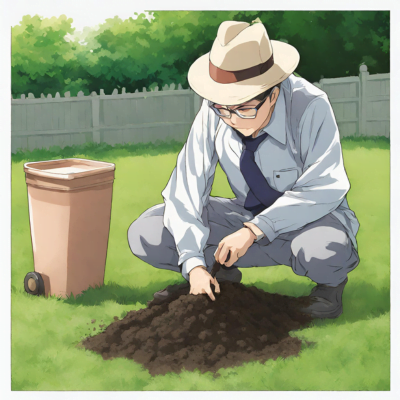
Soil testing is like checking your lawn’s health. It helps you understand if your soil has what your grass needs. Here’s how to do it easily:
Get a Soil Test Kit: You can buy a soil test kit from Amazon.com. It’s a simple tool that tells you about your soil.
Collect Soil Samples: Take small samples of soil from different parts of your lawn. Mix them together.
Follow the Kit Instructions: The kit will have clear instructions on what to do. Usually, you mix your soil with a special solution and use test strips.
Read the Results: The kit will show you the pH level (acid or alkaline) and nutrient levels in your soil.
Why It’s Important:
- Soil testing helps you know if your soil lacks nutrients or has pH problems.
- With this information, you can choose the right fertilizers and treatments to make your grass dark green and healthy.
Plant the right grass
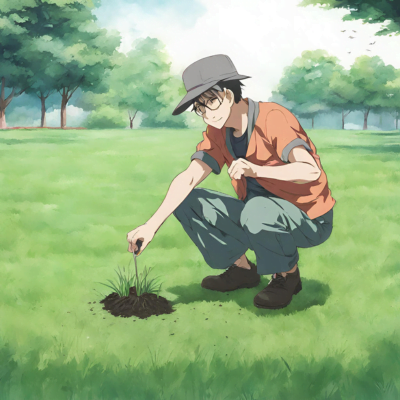
To achieve a dark green lawn, you need to start with the right type of grass. Here’s a simple guide:
Know Your Climate: Different grasses thrive in different climates. Find out if you live in a hot, cold, or moderate climate zone.
Choose the Right Grass Type: Based on your climate, select a grass variety that’s well-suited for your region. Common grass types include Kentucky bluegrass, Bermuda grass, and fescue.
Consider Sunlight: Check how much sunlight your lawn gets. Some grasses love full sun, while others do well in the shade. Choose a grass type that matches your lawn’s sunlight conditions.
Seeding or Sodding: Decide if you want to start from seeds or sod (pre-grown grass). Seeding is cost-effective but takes longer to establish, while sod gives you an instant lawn.
Proper Planting: Follow the planting instructions for your chosen grass type. Ensure good soil contact and moisten the soil during the initial growth period.
Water the grass everywhere
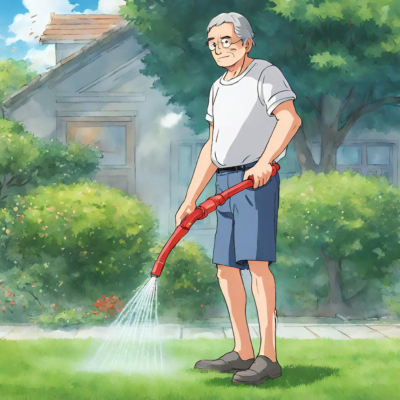
Watering your grass correctly is crucial for achieving and maintaining a dark green lawn. Here’s a simple guide:
Deep and Infrequent: Aim for deep and less frequent sessions instead of shallow and frequent watering. This encourages grass roots to grow deeper.
Morning Watering: Water your lawn in the morning, preferably between 6 a.m. and 10 a.m. This allows the grass to dry before evening, reducing the risk of fungal diseases.
Measure Water Amount: Use a rain gauge or an empty tuna can to measure how much water your lawn receives during each watering session. Aim for about 1 inch of water per week, including rainfall.
Soak the Soil: Water the lawn until the soil is soaked to a depth of 6 inches. This encourages deep-root growth.
Adjust for Weather: You may need to water more frequently during hot and dry periods. In cooler or rainy weather, reduce watering.
Avoid Overwatering: Don’t overwater your lawn, as it can lead to shallow root growth, disease, and weed problems.
Use Sprinklers or Soaker Hoses: Choose a watering method to distribute water across your lawn evenly.
Use the right fertilizer at the right time

Appropriate fertilizer is crucial for achieving and maintaining dark green grass. Fertilizer provides essential nutrients that grass needs to grow and stay vibrant. Here’s a simplified approach:
Choose the Right Fertilizer: Select a fertilizer that matches your soil’s needs, as determined by a soil test. Standard options include balanced fertilizers (10-10-10) or specialized formulations for specific grass types.
Timing is Key: Apply fertilizer during the active growing seasons of spring and early fall. Avoid fertilizing during extreme heat or cold, as your grass may not absorb the nutrients effectively.
Follow Application Instructions: Carefully follow the package instructions for the chosen fertilizer, including the recommended application rates and techniques.
Even Distribution: Use a spreader to distribute the fertilizer across your lawn evenly. This ensures that every part of your lawn gets the nutrients it needs.
Water After Application: Water your lawn after fertilizing to help the nutrients penetrate the soil and reach the grass roots.
Weed Control
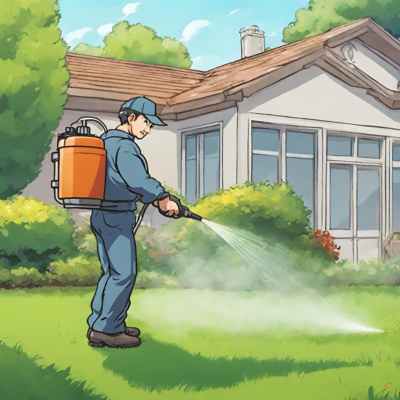
Dealing with weeds is important to keep your lawn looking nice and green. Here’s an easy way to understand weed control:
Spot the Weeds: Walk around your lawn and find the unwanted plants. These are the weeds.
Pull or Use Weed Killer: You can either gently pull weeds out by hand or use weed killer products you can find at the store.
Follow the Instructions: If you use weed killer, read and follow the instructions on the product carefully. Use it as directed.
Prevention: To prevent weeds from coming back, you can also use products called pre-emergent herbicides. These stop weed seeds from growing.
Why It’s Important:
- Weeds can take nutrients and space from your grass, making it less green and healthy.
- By controlling weeds, you help your grass grow better and look dark green.
Pest Management

Pest management is crucial for maintaining dark green grass. Monitor your lawn for signs of pests like grubs, insects, or other critters that can harm your grass. If you spot any issues, consider natural and eco-friendly pest control methods whenever possible to avoid environmental harm. You can also introduce beneficial insects or nematodes that prey on harmful pests. Consult with a professional pest control expert in severe cases to address infestations effectively. By managing pests wisely, you can ensure your grass stays healthy, vibrant, and dark green.
Proper mowing
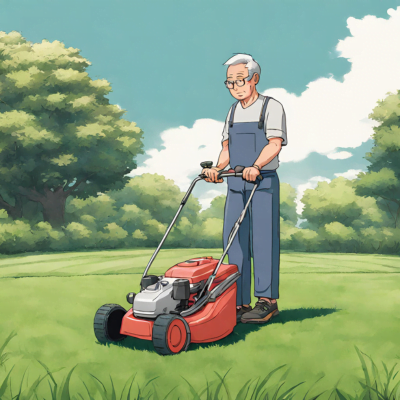
Mowing your lawn the right way is essential for maintaining dark green grass. Follow these simple steps:
Mow at the Right Height: Adjust your mower’s cutting height based on your grass type. For most cool-season grasses like Kentucky bluegrass and fescue, keep it around 2.5 to 3 inches. Warm-season grasses like Bermuda grass can be mowed shorter, typically around 1 to 1.5 inches.
Follow the One-Third Rule: Never cut over one-third of the grass blade’s length in a single mowing. Cutting too much stresses the grass and can lead to a less green appearance.
Keep Blades Sharp: Dull mower blades can tear the grass, leaving it vulnerable to diseases and discoloration. Sharpen your mower blades regularly.
Mow When Dry: Mow your lawn when the grass is dry to achieve cleaner cuts and avoid clumping.
Change Mowing Patterns: Alternate your mowing patterns each time you mow. This prevents the grass from leaning in one direction and encourages upright growth.
Leave Clippings: If your mower has a mulching feature, leave the grass clippings on the lawn. They can provide natural nutrients to the soil.
Maintain a Regular Schedule: Stick to a consistent mowing schedule, usually once a week or as needed. Avoid letting the grass grow too tall before mowing.
Lawn Aeration:
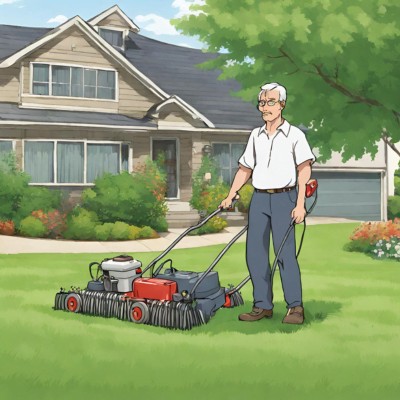
Lawn aeration is a vital practice in the quest for dark green grass. It’s like giving your lawn a breath of fresh air. Over time, soil can become compacted due to foot traffic, heavy equipment, or natural settling. When soil compacts, it restricts the flow of air, water, and nutrients to the grass roots. Aeration involves perforating the soil with small holes to alleviate this compaction and allow essential elements to penetrate the soil more effectively.
You can use a specialized aerator machine or even aerating shoes to create these holes without harming the grass. It’s recommended to aerate your lawn once or twice a year, typically during the growing season, in either spring or early fall. After aeration, your grass will have improved access to nutrients, enabling it to grow stronger and healthier and ultimately achieve that lush, dark green appearance you desire.
Dethatching:
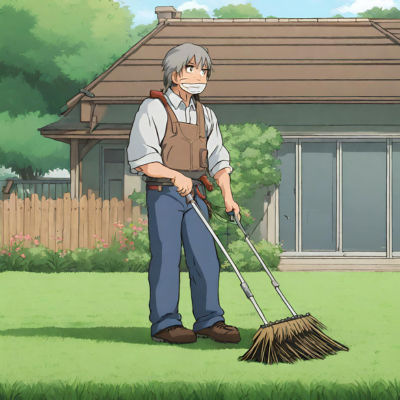
Dethatching is an important lawn care practice that contributes to the health and vibrancy of your grass, essential for achieving a dark green lawn. Thatch is a layer of dead grass, roots, and other organic matter that can accumulate on the soil’s surface over time. While some thatch is customary and beneficial, an excessive thatch layer can become a barrier, preventing air, water, and nutrients from reaching the grass roots. To combat this issue, dethatching involves removing or reducing the thickness of the thatch layer.
You can dethatch your lawn using specialized machines or manually with a dethatching rake. The process entails gently raking or mechanically removing the thatch layer to allow better air circulation, water absorption, and nutrient penetration into the soil. Dethatching is typically performed during the growing season, either in early spring or early fall, depending on your grass type and regional climate. Maintaining a healthy balance of thatch ensures your grass has access to essential resources, helping it stay dark green and thrive.
Seasonal Care:
Proper lawn care varies throughout the year, and understanding the changing needs of your grass during each season is vital to achieving and maintaining dark green grass. Prepare your lawn for growth in spring by dethatching, aerating, and applying a balanced fertilizer. As summer arrives, ensure your grass receives adequate water and monitor it for signs of stress due to heat.
In the fall, adjust your care routine to help your grass prepare for winter by overseeding, applying a winterizing fertilizer, and raking fallen leaves. During winter, protect your lawn from heavy foot traffic and ensure proper snow removal practices. By tailoring your lawn care efforts to each season’s unique requirements, you can foster healthy, resilient grass that remains dark green and lush year-round.
Consistency:
Consistency is the cornerstone of maintaining dark green grass. A regular lawn care routine ensures that your grass receives the essential attention it needs throughout the year. This means mowing your lawn at the appropriate height, watering it consistently, and following a schedule for fertilization and other treatments. Avoid the temptation to neglect your lawn during certain seasons, which can lead to inconsistencies in its health and appearance.
By consistently providing the proper care, you create a stable environment for your grass to thrive, resulting in that coveted dark green, lush lawn that enhances the beauty of your outdoor space. Remember that dedication to routine maintenance is often the secret to long-lasting success in lawn care.
Conclusion
Achieving and maintaining dark green grass is a goal that transforms your lawn into a lush and inviting outdoor space. You must follow a comprehensive and consistent lawn care regimen to attain this vision. It all starts with understanding your grass type and the unique conditions of your lawn. Each step plays a vital role in nurturing dark green grass, from soil testing to proper mowing, watering, and fertilizing.
Lawn aeration, dethatching, and seasonal adjustments ensure your grass remains resilient throughout the year. Pest management, weed control, and sustainability practices protect your lawn’s health and the environment. Lastly, maintaining a consistent routine, always using the right fertilizer at the right time, and providing the necessary attention to your lawn are the keys to success.
Remember, achieving dark green grass is a journey that requires patience and dedication. By implementing these practices and adapting them to your specific lawn conditions, you can transform your lawn into a thriving, vibrant, and dark green oasis that enhances the beauty of your home and provides a welcoming outdoor haven for your family and friends. So, go ahead and embark on this journey to create the lawn of your dreams. Your dark green paradise awaits.
Some Related FAQ
How often should I mow my lawn?
The frequency of mowing depends on the growth rate of your grass and the desired height. Typically, mow your lawn once a week during the growing season, adjusting as needed to maintain the recommended height for your grass type.
Can I use any fertilizer on my lawn?
No, choosing a fertilizer that matches your lawn’s needs is essential, as determined by a soil test. Look for a fertilizer with the right balance of nutrients and follow the recommended application rates and timing.
How can I prevent weeds from taking over my lawn?
To prevent weeds, maintain a healthy, thick lawn through proper mowing, watering, and fertilizing practices. You can also use pre-emergent herbicides to stop weed seeds from germinating.
Is it better to water my lawn in the morning or the evening?
Morning watering is usually recommended. Watering in the morning allows the grass to dry before nighttime, reducing the risk of fungal diseases. It also ensures the lawn receives the water it needs during the day.
How can I tell if my lawn needs aeration?
If your lawn has heavy foot traffic, compacted soil, or poor water absorption, it may benefit from aeration. You can perform a simple “screwdriver test” – if a screwdriver can’t easily penetrate the soil, it’s time to aerate.
What’s the best way to deal with lawn pests?
Monitor your lawn for signs of pests and use eco-friendly pest control methods whenever possible. Beneficial insects and nematodes can help control harmful pests. In severe cases, consult a professional pest control expert.
Can I use natural or organic fertilizers instead of chemical ones?
Yes, natural and organic fertilizers are excellent alternatives to chemical fertilizers. They provide nutrients while improving soil health and are often considered more environmentally friendly.
How long should I wait after fertilizing before letting my pets or children play on the lawn?
Check the instructions on your fertilizer product. Some fertilizers require watering and time to absorb into the soil, while others may recommend staying off the lawn until it’s dry. Always follow the product’s specific guidelines for safety.
Should I bag or mulch grass clippings when I mow?
Mulching grass clippings is generally recommended. It returns valuable nutrients to the soil, acting as a natural fertilizer. Bagging clippings are only necessary if the grass is too long or you want to collect them for other purposes.
How can I protect my lawn during the winter months?
In preparation for winter, ensure your lawn is well-fed and healthy. Rake leaves, avoid heavy traffic, and remove snow promptly to prevent suffocating the grass. Applying a winterizing fertilizer in the fall can also help the grass withstand colder temperatures.
